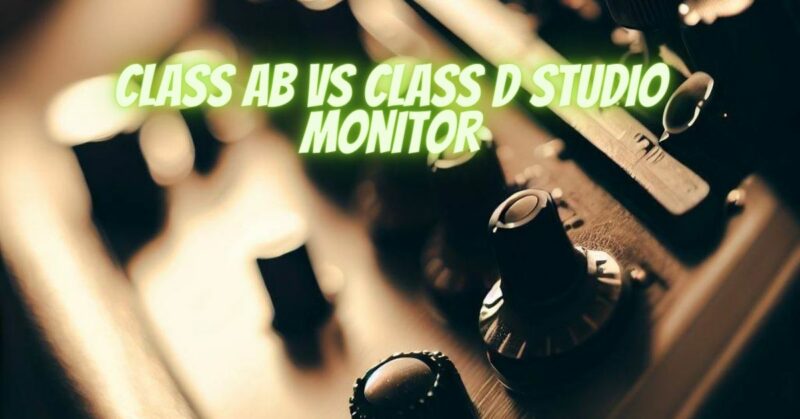In the realm of professional audio production, studio monitors play a pivotal role in achieving accurate and transparent sound reproduction. Two prominent types of studio monitors, Class AB and Class D, have captured the attention of audio engineers and music producers. In this article, we will compare Class AB and Class D studio monitors, delving into their respective characteristics, advantages, and considerations to help you make an informed decision for your audio production needs.
Class AB Studio Monitors:
Overview: Class AB studio monitors are known for their traditional analog amplifier design. They combine features of Class A and Class B amplifiers, allowing them to operate efficiently while maintaining good linearity and low distortion. Class AB amplifiers use both positive and negative voltage swings to reproduce the audio signal, providing a continuous and smooth amplification.
Advantages:
- Sound Quality: Class AB amplifiers are renowned for their high sound quality and accuracy. They offer low distortion and excellent linearity, making them popular among audio professionals seeking precise audio reproduction.
- Smooth Transients: The continuous conduction of Class AB amplifiers ensures smooth transitions between positive and negative portions of the audio waveform, resulting in accurate transient response.
- Midrange Performance: Class AB amplifiers are often praised for their exceptional midrange performance, making them well-suited for critical listening and mixing tasks.
Considerations:
- Power Efficiency: Compared to Class D amplifiers, Class AB amplifiers are less power-efficient, as they continuously draw current even when no audio signal is present.
- Heat Generation: Due to their continuous conduction, Class AB amplifiers can generate more heat, necessitating adequate heat dissipation mechanisms.
Class D Studio Monitors:
Overview: Class D studio monitors utilize digital switching amplifiers, often referred to as PWM (Pulse Width Modulation) amplifiers. These amplifiers switch the output transistors on and off rapidly to represent the audio signal as a series of pulses. Class D amplifiers are highly efficient, as they waste minimal power as heat.
Advantages:
- Efficiency: Class D amplifiers are significantly more power-efficient than Class AB amplifiers, making them suitable for energy-conscious studio setups.
- Compact and Lightweight: The efficiency of Class D amplifiers allows for a more compact and lightweight design, making them ideal for portable and space-constrained studio environments.
- Low Heat Generation: Class D amplifiers produce less heat, reducing the need for extensive heat dissipation mechanisms and contributing to their reliability.
- Bass Performance: Class D amplifiers excel at reproducing low-frequency sounds, making them a popular choice for studio monitors with extended bass response.
Considerations:
- Sound Quality: While modern Class D amplifiers have made significant advancements in sound quality, some audiophiles may perceive a subtle difference in sonic character compared to Class AB amplifiers.
- Switching Artifacts: Early Class D amplifiers suffered from switching artifacts that could affect sound quality. However, advancements in design have minimized these issues in modern Class D amplifiers.
Choosing the Right Studio Monitor for Your Needs:
The choice between Class AB and Class D studio monitors ultimately depends on your specific audio production requirements, budget, and personal preferences. If utmost sound quality, accurate midrange performance, and low distortion are your primary concerns, Class AB studio monitors might be the ideal choice. On the other hand, if you prioritize power efficiency, extended bass response, and portability, Class D studio monitors could be more suitable for your needs.
Regardless of your decision, it is essential to audition and compare different studio monitor models to find the one that best matches your audio production goals. Consider the acoustic properties of your studio space, the genres of music you will be working with, and the specific tasks you need the monitors to perform. By carefully evaluating these factors and understanding the unique characteristics of Class AB and Class D studio monitors, you can make an informed and confident choice that will enhance your audio production journey.

